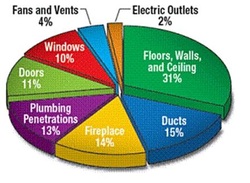Energy Loss
Infrared imaging is especially useful when looking for air leaks, including insulation defects, during an energy audit because it allows me to actually view the apparent temperatures in a given area (note: I do not offer blower door testing when performing an infrared inspection for energy loss). Using an infrared camera, the sources of air leaks can be quickly located and visually documented. Areas of insufficient insulation also becomes more apparent when viewed through an infrared camera and can be visually documented, as well.
Infrared imaging is especially useful when looking for air leaks, including insulation defects, during an energy audit because it allows me to actually view the apparent temperatures in a given area (note: I do not offer blower door testing when performing an infrared inspection for energy loss). Using an infrared camera, the sources of air leaks can be quickly located and visually documented. Areas of insufficient insulation also becomes more apparent when viewed through an infrared camera and can be visually documented, as well.
Insulation Defects
Once a solid difference in temperature has been established between the interior and exterior of the house, insulation defects can be viewed by the camera. By looking at the difference in apparent temperatures, hot and cold spots can be identified as areas that may have missing or inadequate insulation. If a potential problem area is pinpointed using the infrared camera, the insulation in that spot should be examined (if accessible) to verify that it is an issue and to gather more details on the exact nature of the insulation problem. Was insulation moved during a fixture installation and not properly replaced? Is the thickness of the insulation inadequate for the application? These are the types of details I can gather after locating an issue with the insulation.
Where to Look

COMMON AREAS OF AIR LEAKAGE
Knowing what areas to examine for air leaks and insulation issues will speed up the process of finding problems. Infrared equipment is extremely useful for pinpointing the locations of air leaks and specific spots where insulation is inadequate, but it is also useful to know where to start looking for such defects. Air leaks can often be felt with the hand during windy conditions. Also, during cold months, areas of insufficient insulation may be apparent due to the change in temperature in specific spots. I usually start with the following areas, or any area that is already suspected to be leaking air or lacking inadequate insulation:
- light fixtures;
- electrical receptacles;
- windows and doors;
- attic access;
- attic insulation;
- basement rim joists;
- cellar doors;
- crawlspaces;
- ductwork;
- plumbing penetrations;
- plumbing vent pipe penetrations;
- chimney flue and fireplace surrounds;
- dropped soffits;
- dropped ceilings;
- kitchen soffits;
- air handlers;
- cracks between partition top plates and drywall;
- utility chases; and
- baseboards.